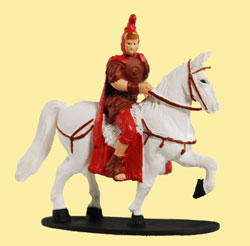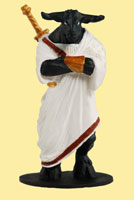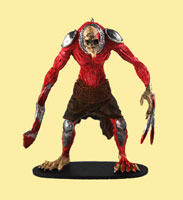GTM #115 - Arcane Legions: How to Play
Aug 21, 2009

|

|

|
In our previous Game Trade Magazine article, we presented a basic overview of our mass action collectable miniatures game, Arcane Legions. Today I’m going to talk more about how to play Arcane Legions.
The first step is to build an army. For the first game, you’ll probably be playing out of the Starter Game. (For $35 you get a two-player Starter with more than 110 figures—enough to begin.) Add figures to your army using Army Packs (commons) and Booster Packs (chase rares). Either way you go, you’ll be aligning yourself with one of three factions: the Egyptian Imperium, Roman Empire, or Han Dynasty. Each faction has its own strengths and weaknesses, allowing players to field armies that fit their play style. Starters contain an army of each faction, and Boosters are faction-specific, so once you choose your faction, you’ll be able to buy just what you need.
 Our battlefield is a simple one, with key strategic points to encourage smart positioning. Some terrain blocks movement, other terrain hinders ranged attacks, and a third type of terrain scores a player victory points.
Our battlefield is a simple one, with key strategic points to encourage smart positioning. Some terrain blocks movement, other terrain hinders ranged attacks, and a third type of terrain scores a player victory points.
On his turn a player receives 8 order points that dictate how many units that player can move, attack with, reorganize, and so on. Each action costs a certain number of order points. Players must balance the use of their order points across the entire battlefield, trying to control terrain and eliminate enemy units. A player wins when he accumulates a certain number of victory points, which he gains by defeating enemy units or occupying control terrain. The game was built to provide simple, engaging game play, so the victory point total is the only number that needs to be tracked over multiple turns.
A unit’s stats (like attack, move, and defense) are all tracked on that unit’s base. Slots in a base are printed with specific stats (like one ranged dice, two attack dice, etc.), and depending on which slots are occupied by figures, the unit’s stats change. During battle players can give reorganization orders to their units to change their formations and activate different stats—like switching from more attack dice to more defense dice—simply by moving figures around on the base. Effective reorganization is key, especially later in the game after units have lost figures by being dealt damage.
Combat is settled through a simple dice-rolling mechanic that works very much like Risk. When a unit is given an attack order, its controller rolls a number of “ready” red attack dice (the combined number of attack dice next to slots in the unit’s base that have figures in them). The defending unit rolls the ready white defense dice it has. Each player’s highest die roll is compared to the other player’s highest die; then second highest rolls are compared; and so on down the line. Each win counts as 1 damage to the other unit in combat. There are no look-up tables, no egregious math. Any special abilities a unit has are tracked on a card that comes with the unit. This simple combat system keeps the game moving and the action happening. All the information needed to play is on the units and the cards.

|

|

|
Keeping with the theme of simplicity, measuring movement in Arcane Legions is easy as well. Instead of using a tape measure or other bulky measurement tool, the game uses extra unit bases. When a unit is given a move order, you count up the number of ready movement icons, then use the edge of an extra base (included in the Starter) to measure the movement. Range is measured in much the same way.
Simplicity is a recurring theme in Arcane Legions. We know that a miniatures game doesn’t need to be complicated to have deep strategy. When the rules are easy to master, players can actually play the game—instead of spending all their time reading the rulebook.

|
***********************


